Autobiography of Gordy Westphal
Autobiography of Gordy Westphal Growing up in the late 1940's and
early 1950's my dad took my brothers and me to the old Eno Ft. Dodge,
Iowa airport. This airport was created in the 30's by business man Ellis
Eno. It consisted of several grass runways, a couple of large hangars
and a small restaurant located in a building on the northeast side of
the airport. This is where I saw my first air show. I still remember
sitting on my father's shoulders so I could see all the activity. Below
is an aerial picture of this airport back then. As I grew up I made
scrap books out of all the newspaper's aviation articles and clippings
from Flying Magazine and began to collect photos whenever I could get my
dad to drive out to the airport on a weekend for a picture taking
session. In the mid 50's an Air Explorer Squadron was formed in Ft.
Dodge. After joining the unit, I received my first airplane ride in a
1948 Cessna 170. It was owned by a local business man, Jim Van Gundy,
who ran a flag making company. Our scout troop made trips to Des Moines
in the Air Guard C-47 and later toured the Air Force facility at Offutt
Air Force Base in Omaha and Sioux City's Air Force Base.
 My Uncle Stan was learning to fly in Cubs at the Eno airport during
the late 30's until WWII curtailed private flying. After the war was
over he resumed his training and when his instructor was ready for him
to begin cross country lessons they went to Middleton, Ohio. They
brought back a new 7AC Champ (N1931E) for its new owner in Ft. Dodge. My
cousin recently gave me Uncle Stan's logbooks, which details the trip
back showing the trip home was completed in one day. They made stops
every hour or two at Lafayette, Streator, Cedar Rapids and home to
Pocahontas to drop Stan off. Later in July of 1950 Stan bought his own
Champ (NC83729) and flew it off his pasture until July of 1956 when it
was sold for health reasons. Every time our families visited together I
enjoyed Stan's stories of learning to fly and maintaining the Champ.
My Uncle Stan was learning to fly in Cubs at the Eno airport during
the late 30's until WWII curtailed private flying. After the war was
over he resumed his training and when his instructor was ready for him
to begin cross country lessons they went to Middleton, Ohio. They
brought back a new 7AC Champ (N1931E) for its new owner in Ft. Dodge. My
cousin recently gave me Uncle Stan's logbooks, which details the trip
back showing the trip home was completed in one day. They made stops
every hour or two at Lafayette, Streator, Cedar Rapids and home to
Pocahontas to drop Stan off. Later in July of 1950 Stan bought his own
Champ (NC83729) and flew it off his pasture until July of 1956 when it
was sold for health reasons. Every time our families visited together I
enjoyed Stan's stories of learning to fly and maintaining the Champ.
Between Christmas and New Year's vacation of 1957 our family moved to
Rochester, MN where my father was building new homes as the result of
IBM building a new facility and an influx of several thousand employees.
After arriving in town I learned of a new Air Explorer Squadron 112
forming under an Air Force Reserve 9709th unit sponsoring the group.
This group of young scouts had about 8 to 12 boys and we met at the
Reserve units meeting rooms or at one of the Gopher Aviation hangars at
the local airport. With sponsorship by an Air Force reserve unit we were
able to obtain (2) C-119 Flying Box Cars to fly boy scouts around
southern Minnesota. This event eventually got to be a safety issue as
the parachutes the scouts wore were too large (35 pounds) for the size
of the boys. If the parachute was ever used some scouts would have been
separated in mid-air from the chute.
While in high school I sat next to a young man (Dennis Finke) who
with his father Emerson had bought a Commonwealth Skyranger and were
learning to fly. On weekends they kept it at the Rochester airport,
which was near their home. Sunday afternoons they would fly it back to
their hangar at Roger's Field located 7 miles NE of Rochester. This
afforded me another chance to get a ride. Most of all though on these
flights I got to meet Roger Tollefsrud who had an 11AC Chief and Everett
and Gary Engel who had bought a PA-12 Super Cruiser and were learning to
fly. Their friendship and help enabled me to eventually purchase my own
first aircraft a Cessna 120 and hangar it at Roger's airport.
 In the winter of 1957-58 a group of IBMer's purchased a J3 Cub
(N33237), and formed a flying club. They were looking for new members to
grow the club and purchased a PA-12 (N7752H). Dale Hugus was the
president and he took me up for a ride in the Cub and I signed up
immediately. At that time membership was $125 but they had a minimum age
requirement of 21 - which I wasn't yet. At the next meeting they voted
to change the age requirement and I became a new member. At the old
Rochester airport, all aircraft, except Gopher Aviation's, sat outside
and during the winter they needed to be preheated. Gopher had a linesman
named Smitty who would come around with a WWII Nelson heater and preheat
the engines. I remember many times seeing cowlings with blistered paint
when too much heat was applied too fast. Being a kid at the time I was
rarely dressed for the cold so felt sorry for Smitty having to be out in
the cold all day long. He was the go to guy to get your engine started,
fuel or tiedown issues.
In the winter of 1957-58 a group of IBMer's purchased a J3 Cub
(N33237), and formed a flying club. They were looking for new members to
grow the club and purchased a PA-12 (N7752H). Dale Hugus was the
president and he took me up for a ride in the Cub and I signed up
immediately. At that time membership was $125 but they had a minimum age
requirement of 21 - which I wasn't yet. At the next meeting they voted
to change the age requirement and I became a new member. At the old
Rochester airport, all aircraft, except Gopher Aviation's, sat outside
and during the winter they needed to be preheated. Gopher had a linesman
named Smitty who would come around with a WWII Nelson heater and preheat
the engines. I remember many times seeing cowlings with blistered paint
when too much heat was applied too fast. Being a kid at the time I was
rarely dressed for the cold so felt sorry for Smitty having to be out in
the cold all day long. He was the go to guy to get your engine started,
fuel or tiedown issues.
 I began to take flying lessons on March 29, 1959. At that time most
of Gophers flight instructors were WWII pilots who shared a lot of
fatherly advice along with the training. Having these men giving advice
as they actually lived through many extreme events to survive the war
was very much well received. We practiced a lot of stalls in climbing
turns, Immelmans, "S" turns and slow flight where the airspeed
indicator needle didn't move much. For communication with the local
tower we used a battery powered Mitchell Airboy Senior transmitting on
122.5 Mghtz and receiving on 278 Kc. In the winter the battery or the
whole radio had to be taken out after each flight and stored in the
Gopher offices. Usually the flight instructor would handle this as they
preferred to be heard rather than have the tower use the light gun.
Luckily back then light signals for the low and slow aircraft was the
primary means of communicating as these radios didn't work all that
well.
I began to take flying lessons on March 29, 1959. At that time most
of Gophers flight instructors were WWII pilots who shared a lot of
fatherly advice along with the training. Having these men giving advice
as they actually lived through many extreme events to survive the war
was very much well received. We practiced a lot of stalls in climbing
turns, Immelmans, "S" turns and slow flight where the airspeed
indicator needle didn't move much. For communication with the local
tower we used a battery powered Mitchell Airboy Senior transmitting on
122.5 Mghtz and receiving on 278 Kc. In the winter the battery or the
whole radio had to be taken out after each flight and stored in the
Gopher offices. Usually the flight instructor would handle this as they
preferred to be heard rather than have the tower use the light gun.
Luckily back then light signals for the low and slow aircraft was the
primary means of communicating as these radios didn't work all that
well.
 I soloed on the 4th of July 1959 and then debated whether I should
buy a '46 Champ for $750 that was for sale at Crystal airport in
Minneapolis or buy a car. The car won out as I was biking to the airport
for lessons in the warm weather or my dad would run me out on the colder
days. I made my long cross country from the old Rochester airport down
to the Ft. Dodge, IA airport where they were holding a flight breakfast.
Back then weather reporting wasn't the greatest so I encountered some
early morning ground fog. As I got down in the Clarion, Iowa area I
decided I better keep an airport in sight so I flew the highway over to
Humbolt and then down to Fort Dodge. The bobber sight gage had quit
bobbling about 30 minutes before landing at Fort Dodge so I wasn't too
surprised when the lineman's ticket read 11.5 gallons in a 12.5 gallon
tank. I continued to fly the Cub through '59 and '60 and then had to
switch over to the PA-12 when the club decided to raffle off the Cub and
buy a Cessna 170A. Each club member was supposed to sell 10 $10 tickets.
One member didn't sell any of his allotment and one of his tickets won
the Cub. I heard he traded it in on a new VW bug. The plane is still
flying in the Jackson Minnesota area. After high school I enrolled in
the Rochester Community College and continued to work on my private
license. I flew the PA-12 east to Winona to take the Private written
exam and after completing the test started up the plane and headed west
to Rochester. After flying for 30 minutes I should have seen the skyline
of Rochester. No luck on seeing Rochester so I dropped down when I saw a
bunch of white painted rocks on the side of a hill. The word was
"RUSHFORD". I had heard of this town but had never been there
so I didn't fully know where it was located. Searching the sectional
chart I finally found the name but the VOR circle for Rochester's
airport was overlaying the town's name. After I figured out the angle
needed to get back on course I was home in 20 minutes.
I soloed on the 4th of July 1959 and then debated whether I should
buy a '46 Champ for $750 that was for sale at Crystal airport in
Minneapolis or buy a car. The car won out as I was biking to the airport
for lessons in the warm weather or my dad would run me out on the colder
days. I made my long cross country from the old Rochester airport down
to the Ft. Dodge, IA airport where they were holding a flight breakfast.
Back then weather reporting wasn't the greatest so I encountered some
early morning ground fog. As I got down in the Clarion, Iowa area I
decided I better keep an airport in sight so I flew the highway over to
Humbolt and then down to Fort Dodge. The bobber sight gage had quit
bobbling about 30 minutes before landing at Fort Dodge so I wasn't too
surprised when the lineman's ticket read 11.5 gallons in a 12.5 gallon
tank. I continued to fly the Cub through '59 and '60 and then had to
switch over to the PA-12 when the club decided to raffle off the Cub and
buy a Cessna 170A. Each club member was supposed to sell 10 $10 tickets.
One member didn't sell any of his allotment and one of his tickets won
the Cub. I heard he traded it in on a new VW bug. The plane is still
flying in the Jackson Minnesota area. After high school I enrolled in
the Rochester Community College and continued to work on my private
license. I flew the PA-12 east to Winona to take the Private written
exam and after completing the test started up the plane and headed west
to Rochester. After flying for 30 minutes I should have seen the skyline
of Rochester. No luck on seeing Rochester so I dropped down when I saw a
bunch of white painted rocks on the side of a hill. The word was
"RUSHFORD". I had heard of this town but had never been there
so I didn't fully know where it was located. Searching the sectional
chart I finally found the name but the VOR circle for Rochester's
airport was overlaying the town's name. After I figured out the angle
needed to get back on course I was home in 20 minutes.
A few more hours were flown with my flight instructor, Darrell
Johnson, to work on the maneuvers for taking the check ride. On the last
preliminary flight it was very hot, bumpy and muggy. I was flying the
PA-12 toward Red Wing on instruments when Darrell proceeded to put the
plane in an attitude that I was to recover from on instruments. Upon
getting the plane back to level flight he closed the throttle, told me
to lift my hood and make an emergency landing. Once I raised the hood I
could see I was right over Roger's Field so I spiraled down and made a
nice landing. I taxied back and began my climb out when I realized my
lunch needed to go immediately. I slid the left pilot's window open, put
my head in the slip stream and watched my lunch and my glasses go flying
in the breeze. I told Darrell what happened to my glasses and he had me
fly us back to the airport which I could but I needed to turn the plane
over to him for landing. Two weeks later with new glasses Darrell gave
me my check ride and I received my Private license.
 While reading my dad's Outdoor Life magazine they had an article on
building a Bensen Gyro Copter you could fly in to your favorite fishing
location and catch the big ones. I wrote off to Bensen for the drawings
and began building my new adventure. After 1 year of work the machine
was finished and was ready for flight. I took it out to Roger's Field
and was able to hangar with Everett's PA-12. I never was able to get the
blades up to peak rpm so after a summer zipping up and down Roger's
runway and graduating from RCC, I decided a real airplane was needed.
Before I sold the gyro I needed to make one more high speed taxi run
down the runway. When I went by the hangars I heard a wop wop, but the
engine was running fine. I pulled off the runway and put it back in the
hangar. As I got into my car for the ride home I felt that my billfold
was missing. The light bulb came on and back to the runway I ran. There
lay the billfold with chopped up one dollar bills and my Private license
in shreds.
While reading my dad's Outdoor Life magazine they had an article on
building a Bensen Gyro Copter you could fly in to your favorite fishing
location and catch the big ones. I wrote off to Bensen for the drawings
and began building my new adventure. After 1 year of work the machine
was finished and was ready for flight. I took it out to Roger's Field
and was able to hangar with Everett's PA-12. I never was able to get the
blades up to peak rpm so after a summer zipping up and down Roger's
runway and graduating from RCC, I decided a real airplane was needed.
Before I sold the gyro I needed to make one more high speed taxi run
down the runway. When I went by the hangars I heard a wop wop, but the
engine was running fine. I pulled off the runway and put it back in the
hangar. As I got into my car for the ride home I felt that my billfold
was missing. The light bulb came on and back to the runway I ran. There
lay the billfold with chopped up one dollar bills and my Private license
in shreds.
Rochester in 1960 relocated the airport to a larger facility 10 miles
south of town so all the planes tied down at the in town location moved
to the new airport. They had constructed several rows of "T"
hangars that were available for rent. Two airplanes were left tied down
next to the hangars and one of these was a 1946 Cessna 120 (N77244). The
fabric was shot so I made an offer of $1000 and my gyro for the 120. The
two partners took me up on the deal and I now owned a real plane.
Everett and Roger helped me disassemble the plane and restore it in
Roger's Quonset hangar. A few weeks later Roger and I hauled the wings
down to Fanta/Reed in LaCrosse, Wisconsin where Ken Reed would cover
them with fresh Grade A fabric that winter. While waiting on the fabric
job I proceeded to reupholster the interior and repaint the landing gear
and wheel pants. After the cold weather began to set in Everett and I
towed the fuselage down to LaCrosse where the plane could be assembled
and given a new license. Come January of 1963 Roger would fly Everett
and me down to LaCrosse and we would fly the plane home.
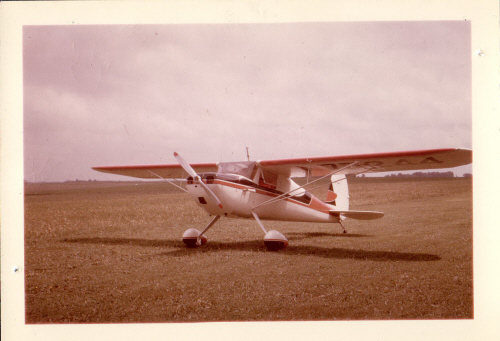 That winter I tied the 120 down on one of Roger's tie downs and began
to learn more about winter flying which included starting your plane in
cold. While trying to start it one cold 20° day, without preheating,
the engine back fired and the primer gas that drained out the airbox
onto the bottom of the cowling ignited. With a battery which was about
dead it could not draw the fuel up into the cylinders. Roger saw what
was happening from the outside and proceeded to stuff an old army coat
into the cowling while hollering at me to keep it turning which was
getting harder and harder to do without a fresh battery. Chalk one more
experience up in my book of knowledge. Thankfully the engine finally
caught which drew the fuel up into the engine.
That winter I tied the 120 down on one of Roger's tie downs and began
to learn more about winter flying which included starting your plane in
cold. While trying to start it one cold 20° day, without preheating,
the engine back fired and the primer gas that drained out the airbox
onto the bottom of the cowling ignited. With a battery which was about
dead it could not draw the fuel up into the cylinders. Roger saw what
was happening from the outside and proceeded to stuff an old army coat
into the cowling while hollering at me to keep it turning which was
getting harder and harder to do without a fresh battery. Chalk one more
experience up in my book of knowledge. Thankfully the engine finally
caught which drew the fuel up into the engine.
 When the Viet Nam war began requiring draftees in 1963, I received
the invite to go up to Minneapolis and have a physical. After passing
the physical I knew within a few months I would be receiving my orders
to report to the Army so I decided to enlist in the Navy's Air Reserve
Squadron VP-815 at NAS Twin Cities. With this enlistment I was able to
attend weekend drills and go on active duty 1 year later. With this 1
year wait I would complete more than 1 year of working for IBM and would
receive an active duty military benefit from IBM. After joining VP-5 at
NAS Jacksonville, Fla. I was placed as an Airman in the electrician
shop. The electricians were in charge of everything electrical on the
SP-2E Neptune except the avionics.
When the Viet Nam war began requiring draftees in 1963, I received
the invite to go up to Minneapolis and have a physical. After passing
the physical I knew within a few months I would be receiving my orders
to report to the Army so I decided to enlist in the Navy's Air Reserve
Squadron VP-815 at NAS Twin Cities. With this enlistment I was able to
attend weekend drills and go on active duty 1 year later. With this 1
year wait I would complete more than 1 year of working for IBM and would
receive an active duty military benefit from IBM. After joining VP-5 at
NAS Jacksonville, Fla. I was placed as an Airman in the electrician
shop. The electricians were in charge of everything electrical on the
SP-2E Neptune except the avionics.
 On deployment in Sigonnella Sicily I joined the Navy flying club that
owned a 7AC Champ, which was wrapped up in a ball. And a T-34 Mentor. A
base club member checked me out for retractable gear and constant speed
prop and then I was free to fly around the island. Several of the fellas
in the shop wanted to see the island as they weren't on aircrew so we
flew often and I never received a bill for use of the plane or fuel.
On deployment in Sigonnella Sicily I joined the Navy flying club that
owned a 7AC Champ, which was wrapped up in a ball. And a T-34 Mentor. A
base club member checked me out for retractable gear and constant speed
prop and then I was free to fly around the island. Several of the fellas
in the shop wanted to see the island as they weren't on aircrew so we
flew often and I never received a bill for use of the plane or fuel.
After our return from duty in Sicily, in the summer of 1965, I was
able to join the flight crew as an AE-3 aircrew on the LA-12. The LA-12
was the 12th SP-2E Lockheed Neptune. The reason I got to do this is
because their electrician only wanted to fly when the squadron was on
deployment. I operated the ECM equipment and still maintained the
electrical items on the plane for my remaining year of service in the
squadron. Most of the time was spent flying the Caribbean training and
looking for Soviet submarines.
 In August of 1965 I returned to Rochester on leave and married Eileen
Tvedt. We returned to Jacksonville for the remainder of my 2 year
enlistment. I had been wanting to build my own airplane so I ordered
drawings for a Whittman Tailwind and a wood material kit from Aircraft
Spruce. The wood kit arrived and Eileen and I would go to the base hobby
shop where she would work on ceramics and I would cut wood and build the
wings. At this time the government was surplusing out gas engines that
provide power to start early jet fighters and bombers. These were
basically a modification of a Lycoming 0-290-D aircraft engine. Maxwell
Propeller Co. in the Dallas, Texas area was offering engines for $125
each. One weekend we had a SP-2E that was headed for Houston, Texas and
they offered to stop by NAS Dallas, drop off myself and a good friend
Chief Dale Kayes, where I could buy an engine and upon their return
would pick us up along with the new engine. This engine would provide
the power for the Tailwind project. I finished the wings while in
Jacksonville and brought them home to Minnesota, Somewhere in the 70's I
sold them to Bob Kloppstein and he (I believe) sold them to someone over
in Eyota, I should have completed that project.
In August of 1965 I returned to Rochester on leave and married Eileen
Tvedt. We returned to Jacksonville for the remainder of my 2 year
enlistment. I had been wanting to build my own airplane so I ordered
drawings for a Whittman Tailwind and a wood material kit from Aircraft
Spruce. The wood kit arrived and Eileen and I would go to the base hobby
shop where she would work on ceramics and I would cut wood and build the
wings. At this time the government was surplusing out gas engines that
provide power to start early jet fighters and bombers. These were
basically a modification of a Lycoming 0-290-D aircraft engine. Maxwell
Propeller Co. in the Dallas, Texas area was offering engines for $125
each. One weekend we had a SP-2E that was headed for Houston, Texas and
they offered to stop by NAS Dallas, drop off myself and a good friend
Chief Dale Kayes, where I could buy an engine and upon their return
would pick us up along with the new engine. This engine would provide
the power for the Tailwind project. I finished the wings while in
Jacksonville and brought them home to Minnesota, Somewhere in the 70's I
sold them to Bob Kloppstein and he (I believe) sold them to someone over
in Eyota, I should have completed that project.
Eileen and I had been married for 1 year when my enlistment was
fulfilled so we moved back to Rochester, MN and my job at IBM. That
first weekend home I called Everett up and met him out at Roger's Field
where he was now flying a 1958 Mooney M20. That weekend he was planning
to fly it to Willmar and trade it in for a 1963 M20A so he offered me a
ride. Not one to pass up a ride we flew over together to make the swap.
After exchanging planes and papers we headed back to Rochester.
 We would be flying close to the Southport airport (Apple Valley) so I
asked Everett if we could drop in and see what activity was going on. On
our weekend flights we enjoyed dropping in at any airports we would be
flying near and if a hangar door was open we would stick our heads
inside to see what was being stored. At Southport on the west side was a
row of old "T" hangars that contained mostly planes that were
built in the 1940's. In the far north hangar sat a Luscombe 8E (N2281K)
that didn't look like it had been flown in a long time. I jotted down
the N number and we continued our browsing. That evening I called a
friend, Earl Freidine, a FAA tower controller at Rochester, and gave him
the N number to research and find out who currently owned the airplane
in the FAA's book of ownership.
We would be flying close to the Southport airport (Apple Valley) so I
asked Everett if we could drop in and see what activity was going on. On
our weekend flights we enjoyed dropping in at any airports we would be
flying near and if a hangar door was open we would stick our heads
inside to see what was being stored. At Southport on the west side was a
row of old "T" hangars that contained mostly planes that were
built in the 1940's. In the far north hangar sat a Luscombe 8E (N2281K)
that didn't look like it had been flown in a long time. I jotted down
the N number and we continued our browsing. That evening I called a
friend, Earl Freidine, a FAA tower controller at Rochester, and gave him
the N number to research and find out who currently owned the airplane
in the FAA's book of ownership.
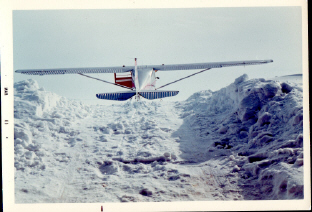 Later in the week Earl called me back and said it belonged to Walt
Kollath, a Northwest mechanic. So I gave him a call to see if it would
be available for sale. He said he was building a Cassutt racer and that
the Luscombe could be bought for $3000 as he needed the hangar space.
The price was a little high at the time but the plane didn't have any
paint except the red trim and I wanted to do some polishing. A deal was
struck and one evening that next week Everett flew me up to Southport
and home I came with my new plane. Not out of the Navy 2 weeks and I was
back in the air. The plane received a fresh polish, new paint on the
bottom of the wings, new interior, instrument panel and a radio. The
Luscombe took Everett and I all over Minnesota, Iowa, Wisconsin and
Illinois for several hundred hours over the next 3 years. By then Scot
was born and his mother decided a house was next on the list - so the
Luscombe made one final flight to Sycamore, Illinois to its new owner.
Later in the week Earl called me back and said it belonged to Walt
Kollath, a Northwest mechanic. So I gave him a call to see if it would
be available for sale. He said he was building a Cassutt racer and that
the Luscombe could be bought for $3000 as he needed the hangar space.
The price was a little high at the time but the plane didn't have any
paint except the red trim and I wanted to do some polishing. A deal was
struck and one evening that next week Everett flew me up to Southport
and home I came with my new plane. Not out of the Navy 2 weeks and I was
back in the air. The plane received a fresh polish, new paint on the
bottom of the wings, new interior, instrument panel and a radio. The
Luscombe took Everett and I all over Minnesota, Iowa, Wisconsin and
Illinois for several hundred hours over the next 3 years. By then Scot
was born and his mother decided a house was next on the list - so the
Luscombe made one final flight to Sycamore, Illinois to its new owner.
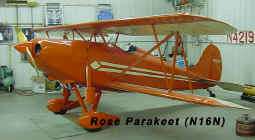 A home was purchased and the move was made the end of September 1969.
By this time John Hanson and Dick Borg had talked me into building a
Rose Parakeet (N16N) (Hannaford D-4) biplane so wood and steel was
ordered and I began to build wing ribs. One month hadn't yet gone by
when I began to have flight withdrawals. While out visiting with Roger
and Everett,
A home was purchased and the move was made the end of September 1969.
By this time John Hanson and Dick Borg had talked me into building a
Rose Parakeet (N16N) (Hannaford D-4) biplane so wood and steel was
ordered and I began to build wing ribs. One month hadn't yet gone by
when I began to have flight withdrawals. While out visiting with Roger
and Everett,  Roger mentioned he had a friend who might be selling a J-3
Cub. I asked Roger to look into purchasing the plane and shortly Roger
and I were headed to LaCrosse to pick up the new project. The fuselage
had been recovered several years prior but the
Roger mentioned he had a friend who might be selling a J-3
Cub. I asked Roger to look into purchasing the plane and shortly Roger
and I were headed to LaCrosse to pick up the new project. The fuselage
had been recovered several years prior but the 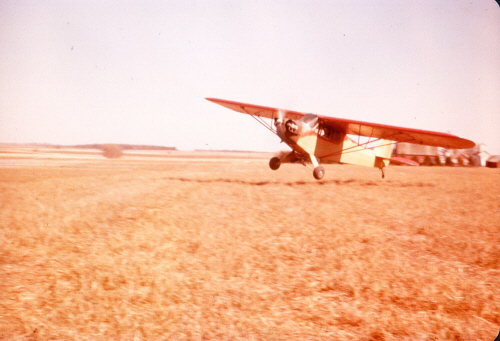 wings needed new fabric
before a new annual could be made. I disassembled the wings, bought new
fabric, wing tips, butyrate dope and by spring the wings and the
fuselage were ready to go out to Roger's Field for reassembly and a
fresh annual. Winter time brought out the ski's that were saved when the
Luscombe was sold. Many flight were made up to Linwood Lake where
Everett's son Gary and wife Carol would have the coffee pot on for 2
cold flyers. The Cub never made it out of Iowa and Minnesota but Scot
and Darin got their first plane rides in N6697H and this airplane also
is alive and well in the St. Cloud area.
wings needed new fabric
before a new annual could be made. I disassembled the wings, bought new
fabric, wing tips, butyrate dope and by spring the wings and the
fuselage were ready to go out to Roger's Field for reassembly and a
fresh annual. Winter time brought out the ski's that were saved when the
Luscombe was sold. Many flight were made up to Linwood Lake where
Everett's son Gary and wife Carol would have the coffee pot on for 2
cold flyers. The Cub never made it out of Iowa and Minnesota but Scot
and Darin got their first plane rides in N6697H and this airplane also
is alive and well in the St. Cloud area.
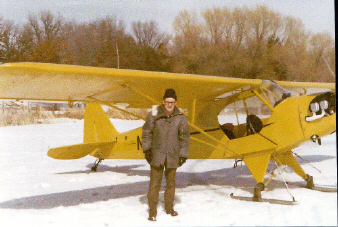 Several members of the EAA Chapter 100 were building hangars at Dodge
Center so I joined them with a building that could hold 2 full size
planes. The J3 was hangared with Earl Friedlines Piper Tripacer and
later Cal McNutts Volksplane.
Several members of the EAA Chapter 100 were building hangars at Dodge
Center so I joined them with a building that could hold 2 full size
planes. The J3 was hangared with Earl Friedlines Piper Tripacer and
later Cal McNutts Volksplane.
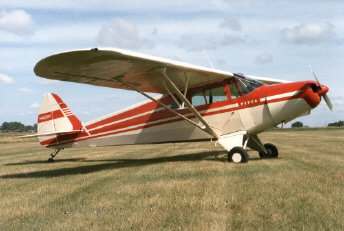 Gary Engel was also flying a J3 on floats from his lakeside home and
before long realized that he needed more load carrying ability so a
PA-12 was bought for rebuilding. Flying at 75-80 mph didn't get me there
very fast so I also bought a PA 12 (N4219M) from Ward Holiday at Lake
Elmo and sold the J3 to a local flyer, Roger Barnes. After a couple
years of flying time with the 100 hp engine I felt a little more power
would help on those warm days. I purchased a 135 hp Lycoming from Bill
Morse up in Grand Rapids and shortly Walt Mount and I had it installed
with a new annual license. All around this plane was the best I owned
with reasonable speed, range, and load carrying.
Gary Engel was also flying a J3 on floats from his lakeside home and
before long realized that he needed more load carrying ability so a
PA-12 was bought for rebuilding. Flying at 75-80 mph didn't get me there
very fast so I also bought a PA 12 (N4219M) from Ward Holiday at Lake
Elmo and sold the J3 to a local flyer, Roger Barnes. After a couple
years of flying time with the 100 hp engine I felt a little more power
would help on those warm days. I purchased a 135 hp Lycoming from Bill
Morse up in Grand Rapids and shortly Walt Mount and I had it installed
with a new annual license. All around this plane was the best I owned
with reasonable speed, range, and load carrying.
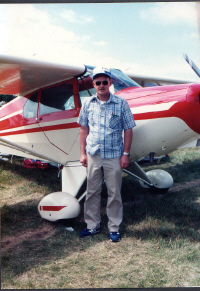 Two flights stand out in my memories in the PA-12. The first one was
in 1973. Gary flew his PA-12 up to Ft. Francis, Ontario and Everett and
I flew my PA-12 up to Ft. Francis where Gary after unloading fishing
gear and the boat at Lake Tesup flew over and picked us up for a week of
fishing. We stopped at a small lake before Tesup but only caught
Northerns. Later we went into Tesup and caught Walleyes for every meal.
One afternoon we flew north to a lodge for a port chop dinner. Friday,
Gary took me back to Ft. Francis and after some ground fog around
Hibbing cleared I was home that afternoon. The other trip was when Dee
Sherden and I flew down to Bartlesville, OK for an antique fly-in. Going
down we flew at 10,500 feet to get a nice tailwind. After the 4 hour
flight and we landed, I had a headache that lasted for 3 days. Maybe if
I would have taken an aspirin before the flight it could have been
prevented.
Two flights stand out in my memories in the PA-12. The first one was
in 1973. Gary flew his PA-12 up to Ft. Francis, Ontario and Everett and
I flew my PA-12 up to Ft. Francis where Gary after unloading fishing
gear and the boat at Lake Tesup flew over and picked us up for a week of
fishing. We stopped at a small lake before Tesup but only caught
Northerns. Later we went into Tesup and caught Walleyes for every meal.
One afternoon we flew north to a lodge for a port chop dinner. Friday,
Gary took me back to Ft. Francis and after some ground fog around
Hibbing cleared I was home that afternoon. The other trip was when Dee
Sherden and I flew down to Bartlesville, OK for an antique fly-in. Going
down we flew at 10,500 feet to get a nice tailwind. After the 4 hour
flight and we landed, I had a headache that lasted for 3 days. Maybe if
I would have taken an aspirin before the flight it could have been
prevented.
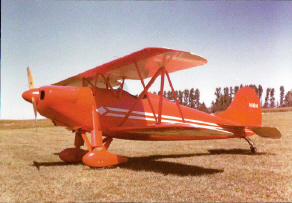 The Parakeet project was well along and by the end of 1977 the cover
was installed and assembly was underway through the fall months. First
flights were in the winter of '77. I had put about 10 hours on the plane
and on one 10°F day I decided to make my first flight over to Rochester
from Dodge Center. I had gotten between Byron and Rochester when the
windshield was covered with grease like oil from the cold and I figured
I had frozen my breather line and blew open the crankshaft seal. A quick
180° turn and I was back at Dodge Center Airport in a few minutes.
After landing and wiping off the goo wherever the oil was slung I saw
the seal was OK but the crankshaft oil plug had blown out the front of
the crankshaft. A new educational moment. When assembling the engine I
failed to seat the plug in the new crankshaft with a wooden dowel after
it was positioned in place. At this time of my flying I had over 1000
hours of time from J-3's to a Navy flying club T-34.
The Parakeet project was well along and by the end of 1977 the cover
was installed and assembly was underway through the fall months. First
flights were in the winter of '77. I had put about 10 hours on the plane
and on one 10°F day I decided to make my first flight over to Rochester
from Dodge Center. I had gotten between Byron and Rochester when the
windshield was covered with grease like oil from the cold and I figured
I had frozen my breather line and blew open the crankshaft seal. A quick
180° turn and I was back at Dodge Center Airport in a few minutes.
After landing and wiping off the goo wherever the oil was slung I saw
the seal was OK but the crankshaft oil plug had blown out the front of
the crankshaft. A new educational moment. When assembling the engine I
failed to seat the plug in the new crankshaft with a wooden dowel after
it was positioned in place. At this time of my flying I had over 1000
hours of time from J-3's to a Navy flying club T-34.
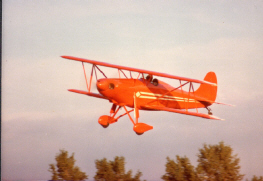 With the Parakeet flying and the Grade A fabric on the PA-12 getting
weaker a major OH of the plane was undertaken. An extended baggage
compartment was built and the wing tank fuel gages were changed to PA-18
gages in the wing roots. The 300x4 wheels were changed over to a
Cleveland 600x6 wheel and brake STC. The rebuild took from 1980 to 1985.
During the summer of 1985 the Piper Cub Club held their first fly in at
Anderson, IN. Everett and I attended in the PA-12 and the plane was
judged best restored Piper. In 1987 I flew the PA-12 to Lock Haven, PA
for its first return to its place of birth. I also flew the plane to
Blakesburg, IA and also earned a People's Choice and Best of Type award.
With the Parakeet flying and the Grade A fabric on the PA-12 getting
weaker a major OH of the plane was undertaken. An extended baggage
compartment was built and the wing tank fuel gages were changed to PA-18
gages in the wing roots. The 300x4 wheels were changed over to a
Cleveland 600x6 wheel and brake STC. The rebuild took from 1980 to 1985.
During the summer of 1985 the Piper Cub Club held their first fly in at
Anderson, IN. Everett and I attended in the PA-12 and the plane was
judged best restored Piper. In 1987 I flew the PA-12 to Lock Haven, PA
for its first return to its place of birth. I also flew the plane to
Blakesburg, IA and also earned a People's Choice and Best of Type award.
Scot decided he wanted to take flight training after high school so
he enrolled in the program at the University of North Dakota at Grand
Forks. After making this drive a few times I began to shop around for a
4 place plane. A Grumman Tiger (N4524Y) was for sale at Dodge Center so
I sold the PA-12 and moved up to the Tiger. Full 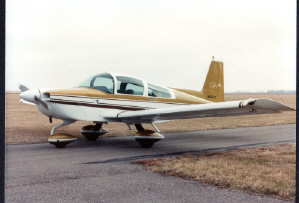 IFR with autopilot and
an engine with 200 hours since major OH. We flew up to Grand Forks
several times to attend football games and to pick up Scot for the
holiday. These trips were nice as we could also visit my folks at Park
Rapids. After a couple years of training Scot decided flying wasn't for
him so we moved him back to Rochester. About this time a polished Cessna
170B was offered to me by a friend of my Uncle Stans at Pocahontas,
Iowa. The Tiger was sold to a man in St. Paul who didn't keep it long
but sold it to someone in New Hampshire who totaled the plane in the
mountains. (The only plane I have owned that's not flying). The 170
(N2889C) was a farmers airplane and I disassembled it and began
polishing wherever I could get the original finish to be restored. The
undersurfaces of the wings and tail were painted with a Chevy Corvette
Silver Pearl urethane which greatly helped to prevent corrosion and
lifting that hefty buffer. New red trim and Cessna decals were applied
and the interior headliner and carpet replaced. The seats were still in
good shape. The instrument panel was repainted and several instruments
overhauled. A com radio went back in the panel but a portable Loran was
used for navigation. About the time I was
IFR with autopilot and
an engine with 200 hours since major OH. We flew up to Grand Forks
several times to attend football games and to pick up Scot for the
holiday. These trips were nice as we could also visit my folks at Park
Rapids. After a couple years of training Scot decided flying wasn't for
him so we moved him back to Rochester. About this time a polished Cessna
170B was offered to me by a friend of my Uncle Stans at Pocahontas,
Iowa. The Tiger was sold to a man in St. Paul who didn't keep it long
but sold it to someone in New Hampshire who totaled the plane in the
mountains. (The only plane I have owned that's not flying). The 170
(N2889C) was a farmers airplane and I disassembled it and began
polishing wherever I could get the original finish to be restored. The
undersurfaces of the wings and tail were painted with a Chevy Corvette
Silver Pearl urethane which greatly helped to prevent corrosion and
lifting that hefty buffer. New red trim and Cessna decals were applied
and the interior headliner and carpet replaced. The seats were still in
good shape. The instrument panel was repainted and several instruments
overhauled. A com radio went back in the panel but a portable Loran was
used for navigation. About the time I was  restoring the 170, a
neighboring hangar was sold to a fella who was completing a 2 place
tandem called a RV4. We got to helping each other out and Ken Brown and
I became good friends. Later Ken got the RV4 licensed and flying so we
flew the RV4 all over Minnesota, Iowa and Wisconsin for lunch or to look
at other peoples projects. Some of the places were casinos as Ken enjoys
helping the Indians out. Come to think of it he still is helping them
out. Al Hanson, a hangar owner next to Ken, bought a 2 place
experimental Mustang and with similar speeds we hit many lunch spots
together until Al and his wife Arlene decided to retire to southern
Michigan. Also another RV4 was acquired by Brandon McNeilus at about
this time and he to would be found flying around the area with the
faster crowd of planes. After completing his RV4 Ken began work on an
RV6.
restoring the 170, a
neighboring hangar was sold to a fella who was completing a 2 place
tandem called a RV4. We got to helping each other out and Ken Brown and
I became good friends. Later Ken got the RV4 licensed and flying so we
flew the RV4 all over Minnesota, Iowa and Wisconsin for lunch or to look
at other peoples projects. Some of the places were casinos as Ken enjoys
helping the Indians out. Come to think of it he still is helping them
out. Al Hanson, a hangar owner next to Ken, bought a 2 place
experimental Mustang and with similar speeds we hit many lunch spots
together until Al and his wife Arlene decided to retire to southern
Michigan. Also another RV4 was acquired by Brandon McNeilus at about
this time and he to would be found flying around the area with the
faster crowd of planes. After completing his RV4 Ken began work on an
RV6.
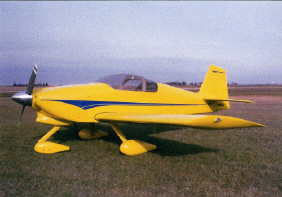 As I was nearing retirement age a RV6A with tri-gear looked like a
project I should build. So in 1997 Ken and I flew down to Boone, IA
where I purchased the necessary riveting tools to start a kit. The RV4
was maxed out with people, tools, and fuel but performed well and
brought us home to Dodge Center.
As I was nearing retirement age a RV6A with tri-gear looked like a
project I should build. So in 1997 Ken and I flew down to Boone, IA
where I purchased the necessary riveting tools to start a kit. The RV4
was maxed out with people, tools, and fuel but performed well and
brought us home to Dodge Center.
Before completing the plane Brandon asked if I would like to go in
with him and build a double wide hangar on one of the last spots
available where the ground had been prepared and a new taxiway
constructed. Morton buildings put up the hangar in 1999 and that winter
Brandon supplied materials and I added purloins and insulation to the
hangar. Furnaces were hung on both sides of the building and Ken stopped
by and I helped him handle the wiring and install the lights. It was
finally nice to have heat and adequate lights. February of 2000 I
retired from IBM after 37 years and proceeded to go to the airport just
about every day if the weather cooperated.
I n the summer of 2002 the RV6A (N17GE) was completed and arrangements
were made with John Roscoe from Albert Lea to inspect the plane for its
first test flight. The plane flew great and the speed and takeoff
performance was more than I had hoped. That winter I decided to sell the
170B and just before Christmas a man from NW Denver came out with some
friends and flew the plane to Colorado. The 170B is still owned by the
same man and kept at a private strip NW of Denver. The next summer I
built a paint booth and painted the RV Vans Dynamite Yellow.
n the summer of 2002 the RV6A (N17GE) was completed and arrangements
were made with John Roscoe from Albert Lea to inspect the plane for its
first test flight. The plane flew great and the speed and takeoff
performance was more than I had hoped. That winter I decided to sell the
170B and just before Christmas a man from NW Denver came out with some
friends and flew the plane to Colorado. The 170B is still owned by the
same man and kept at a private strip NW of Denver. The next summer I
built a paint booth and painted the RV Vans Dynamite Yellow.
I flew the RV6A until summer of 2011 when the doctors at Mayo wanted
to go in and examine the arteries around my heart. While doing the
examination they placed a stent in the upper location. The Olmsted
Medical flight surgeon said I shouldn't have any trouble getting a new
medical but I decided not to risk being denied by medical so I placed
the RV up for sale and in the spring I found a buyer from the Peachtree
area of Georgia that wanted the plane. One Saturday morning in April he
flew to the Rochester airport. I picked him up and we drove to Dodge
Center where Kurt Hiner would check him out and we handle the paper
work. At supper time that evening he called from the Atlanta area and
had arrived home after a 4 hour flight. I have heard from him only once
to ask about the paint color to do some touch up. I check on FlightAware
every now and then to see where he has been flying it IFR and he  has now
loaded a picture of the plane N17GE. It still looks GREAT. After the
operation I decided I would now be flying under Light Sport rules so
Stan Blankenship and I drove down to Sulphur Spring, MO and brought home
a 7AC Champ (N83387) that needed a total rebuild. This was in the fall
of 2007 and the rebuild took until the summer of 2013. The wings
received new spars, tips, leading and trailing edges and new hardware.
The right hand wing received new ribs and a 5.5 gallon aux tank. The
fuselage had new bottom longerons and damaged tubing repaired. New floor
boards, baggage compartment, headliner, seats, OH instruments, and a new
instrument panel. A local man had a damaged Ercoupe for sale so this was
bought so I could install its Continental 90 hp engine in the Champ. I
wanted a starter so I wouldn't need a tail tie down or assistance in
hand propping. The engine required new cylinders, crankshaft, magnetos,
starter, carburetor, airbox, baffling and a prop overhaul. After the
fabric was applied I painted it in 1956 Champion colors and paint
scheme. A lot of time and effort but it looks pretty much factory
original. The factory in the mid 1950's was Holman Field at St. Paul,
MN.
has now
loaded a picture of the plane N17GE. It still looks GREAT. After the
operation I decided I would now be flying under Light Sport rules so
Stan Blankenship and I drove down to Sulphur Spring, MO and brought home
a 7AC Champ (N83387) that needed a total rebuild. This was in the fall
of 2007 and the rebuild took until the summer of 2013. The wings
received new spars, tips, leading and trailing edges and new hardware.
The right hand wing received new ribs and a 5.5 gallon aux tank. The
fuselage had new bottom longerons and damaged tubing repaired. New floor
boards, baggage compartment, headliner, seats, OH instruments, and a new
instrument panel. A local man had a damaged Ercoupe for sale so this was
bought so I could install its Continental 90 hp engine in the Champ. I
wanted a starter so I wouldn't need a tail tie down or assistance in
hand propping. The engine required new cylinders, crankshaft, magnetos,
starter, carburetor, airbox, baffling and a prop overhaul. After the
fabric was applied I painted it in 1956 Champion colors and paint
scheme. A lot of time and effort but it looks pretty much factory
original. The factory in the mid 1950's was Holman Field at St. Paul,
MN.
There are 85 hours on the plane since rebuild and I still have a
couple items I would like to make changes on but it also flies great. I
am looking at selling the parakeet in the near future. It has 500 hours
TT on it and is not getting flown very much as insurance is more than I
want to pay for just a few hours of flying each year. My total flying
time is 2967 hours since I started learning to fly in 1959. I should
make the 3000 hour mark this summer - 2015.
Stan and I were shooting the breeze at the Dodge Center A/D building
in early February when the subject got around to rebuildable projects
available in the area and the Piper Colt that was damaged at the
Rochester airport several years back. A call was made to the owner and
he was looking for someone that had the time to put it back together. A
few weeks later the plane was dropped off at my hangar and I now have a
windshield trimmed and fitted and ready to install. New Cleveland wheels
and brakes have been installed and I have started to clean up the
elevators before a fresh coat of Polytone can be sprayed. The wings were
repaired and recovered at Owatonna and will be installed once the new
W/S is installed. Hope this plane can be returned to the owner by
midsummer.
Summary of Gordy's aircraft ownership history
" Built Bensen Gyro Copter " Traded Gyro Copter for a
Cessna 120 (N77244) +$1000 " Built wings for a Whittman Tailwind
" Rebuilt Luscombe 8E (N2281K) " Built Rose Parakeet 1969-1977
(N16N) " Sold Luscombe " Rebuilt J-3 Cub " Sold J-3 to
buy PA-12 - upgraded engine then rebuilt " Sold PA-12 for a Grumman
Tiger (N4524Y) " Sold Grumman for a Cessna 170 (N2889C) "
Summer 2002 finished building RV6A (N17GE) " Winter 2002 Sold
Cessna 170B " 2011 sold RV6A (N17GE) " Between 2007 and 2013
rebuilt 7AC Champ (N83387)
Click pictures below to enlarge